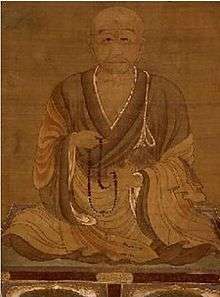Genshin
Genshin (源信; 942 – July 6, 1017), also known as Eshin Sozu, was the most influential of a number of Tendai scholars active during the tenth and eleventh centuries in Japan. He was one of the thinkers who maintained that the nenbutsu ritual, which was said to induce a vision of Amida, was an important hermeneutic principle in the Buddhist doctrinal system.[1]

The Buddhist master was one of the two leading disciple of Ryogen along with Kakuun.[2] He studied both esoteric and esoteric teachings under this master, who was the 18th head of the Enryakuji Temple.[3]
Teachings
Genshin was not a wandering evangelist as Kūya was, but was an elite cleric who espoused a doctrine of devotion to Amida Buddha which taught that because Japan was thought to have entered mappō, the "degenerate age" of the "latter law," the only hope for salvation lay in the reliance on the power of Amitabha. Other doctrines, he claimed, could not aid an individual because they depended on "self-power" (jiriki), which cannot prevail during the chaos of the degenerate age, when the power of another (tariki) is necessary. In his approach to rebirth in the Pure Land, Genshin emphasized visual meditation practices, where later Pure Land sects favored verbal recitations such as the nembutsu. Genshin's doctrine is documented in his magnum opus, the Ōjōyōshū (往生要集, "Essentials of Birth in the Pure Land"), which in later copies of the text came complete with graphic depictions of the joy of the blessed and the suffering of those doomed to chaos.
Genshin's influence in contemporary Japanese culture today is primarily due to his treatise, Ōjōyōshū, particularly the graphic descriptions of the Buddhist hell realms (地獄 jigoku), which inspired a genre of horror and morality stories. The 1960 Japanese film Jigoku was influenced by Genshin's Ōjōyōshū among other works. In Jodo Shinshu Buddhism, he is considered the Sixth Patriarch.
Genshin is credited as the founder of the Enshin school of Tendai Buddhism, and for espousing the "original enlightenment" teaching, or hongaku (本覚), where one is originally enlightened, but unaware of it. In all, Genshin left more than 30 works which continue to influence Pure Land thought today.[4]
The image of Amida Nyorai in the main building of Yasaka-ji Temple in Shikoku is said to have been made by Genshin in the Heian Period.[5]
References
- Kopf, Gereon (2018). Dao Companion to Japanese Buddhist Philosophy. Berlin: Springer. p. 373. ISBN 9789048129232.
- Stone, Jacqueline Ilyse (1999). Original Enlightenment and the Transformation of Medieval Japanese Buddhism. Honolulu, Hawaii: University of Hawaii Press. p. 118. ISBN 0824820266.
- Nichiren (2002). Writings of Nichiren Shonin: Doctrine 2. University of Hawaii Press. ISBN 9780824825515.
- "Biographies of Dharma Masters". Archived from the original on 8 May 2009. Retrieved 25 November 2008.
- "熊野山 妙見院 八坂寺". Archived from the original on 14 February 2015. Retrieved 15 February 2017.
Further reading
- Horton, Sarah (2004). The Influence of the Ōjōyōshū in Late Tenth- and Early Eleventh-Century Japan, Japanese Journal of Religious Studies 31 (1), 29-54
- Rhodes, Robert F. (2007). Ōjōyōshū, Nihon Ōjō Gokuraku-ki, and the Construction of Pure Land Discourse in Heian Japan, Japanese Journal of Religious Studies 34 (2), 249-270
- Rhodes, Robert F. (2001). Some Problems concerning Genshin's Biographies, Journal of Indian and Buddhist Studies (Indogaku Bukkyogaku Kenkyu) 50 (1), 514-511